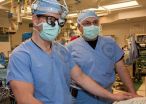(Press-News.org) January 18, 2013 – New Orleans – When mom is the boss at home, she may have a harder time being the boss at work. New research suggests that women, but not men, become less interested in pursuing workplace power when they view that they are in control of decision-making in the home. This shift in thinking affects career choices without women even being aware.
"Women don't know that they are backing off from workplace power because of how they are thinking about their role at home," says Melissa Williams of Emory University. "As a result, women may make decisions such as not going after a high-status promotion at work, or not seeking to work full time, without realizing why," explains Williams who will be presenting her findings today at the Society of Personality and Social Psychology (SPSP) annual meeting in New Orleans.
Her new study is one of several at the SPSP meeting that will explore a continued gender gap in workplace power – from how women versus men view their roles in the home to how gender stereotypes form at a young age to how these attitudes affect women's likelihood of pursuing careers in science and math. "Even as we see great gains made by women in the workforce, we continue to also see disproportionately larger numbers of women leaving successful careers, or diverting their career paths to ones with fewer hours and greater flexibility, but that also hold less status," says Bernadette Park of the University of Colorado Boulder.
When women rule at home
We often speak about women as being decision-making experts or powerholders in the home setting – for example, expecting that men will defer to their wives' decisions regarding clothing. But while people intend these references to be complimentary to women, Williams says, "such language may have a negative effect on the decisions they make about their lives outside the home, without them being aware of it."
To test this effect, Williams and colleagues first surveyed people to gauge their views of power in household decisions-making. Both men and women perceived power over household decisions as being desirable and making a person feel powerful.
They then asked men and women aged 18 to 30 years old to imagine that they were married and had a child in one of three conditions: either they make many of the decisions; they make decisions together with their spouse; or they perform most of the household tasks with no mention of household decision-making power. Women were less interested in pursuing work goals when they had household power, compared to sharing equal power with a spouse. Men's interest in work goals, however, was unaffected by their household power.
Also, women's interest in workplace power did not change simply by imagining that they were performing household tasks. "It is only when such tasks are described as involving power that they negatively affect women's motivation to pursue workplace power," Williams says. "We think this is because referring to women's household role as one involving power puts a positive spin on women's traditional role on the home, and makes it seem more appealing."
"It is one thing for a woman to choose to stay at home if she wishes her primary role be that of wife and mother," Williams says. "But when the language we use to talk about household chores makes such a role unconsciously more appealing to women, without the same effect on men, this is not what most people think of as making a free choice."
When mom and worker collide
Women have some even more basic obstacles to overcome when working at both home and in the workplace. According to new study, women experience conflict in managing their identities as a parent and a worker at the same time, much more so than men.
"The basic premise of this research is that cultural stereotypes of the 'ideal mom' conflict with stereotypes of the 'ideal worker' and in particular the 'ideal professional,' says Park of the University of Colorado Boulder. "In contrast, for men, successfully fulfilling the role of professional in part also fulfills obligations associated with the 'ideal dad,'" such as being a provider and being decisive. "For women, the identities of mom and professional are experienced in opposition or conflict with one another in a way that dad and professional are not for men."
Park and colleagues measured how easily women and men associate themselves with career versus family goals through a series of "implicit" association tests that measure how quickly people categorize words within the two goal domains. They found that women often had to "switch hats" in thinking about parenting versus work, while men primarily associated themselves with just work.
They also found that women performed more poorly on cognitive tasks after experiencing shifts in how they associate with these two identities, but not before. Men showed no such depletion of cognitive capacities. The researchers further found that when women received negative feedback related to a career-related task, they would more strongly "activate" their identity as a parent, "as if easing the sting of the failure," Park says.
The data together suggest that "one of the greatest challenges faced by women in trying to 'have it all' is that they experience a psychological conflict in their most basic identities not true of men," Park says. "Mentally, they have to shift back and forth between self-conceptions of self-as-mom versus self-as-professional and these two selves do not reside easily next to each other."
When children follow what you do not what you say
Even when women work full-time, they often still shoulder a disproportionate amount of domestic responsibilities at home. This division of labor can fundamentally change how children view their gender roles, even if parents teach their children to be egalitarian, according to new research.
"When it comes to learning gender roles, actions and implicit attitudes might speak louder than words," says Toni Schmader of the University of British Columbia. "Parents pride themselves on teaching their kids that they can be anything they want to be. However, parents' own behavior and entrenched cultural associations continue to reinforce more traditional gender roles."
Looking at male and female children between the ages of 7 and 13 and dads and moms, all in heterosexual cohabiting relationships, the researchers, led by Schmader and graduate student Alyssa Croft, tested implicit attitudes toward men and women in the workplace versus home. They also asked their parents about their paid work hours and relative contribution to domestic tasks at home and asked children about preferences for gender-stereotypical toys, shows, and future roles or occupations.
The researchers found that regardless of whether parents explicitly endorsed gender-egalitarian roles, if their actual behaviors modeled a more traditional division of household labor, their children – especially their daughters – preferred more gender-typical toys, TV shows, and future occupations.
They also found that women performed more of the domestic tasks at home, even after controlling for fewer hours spent at work compared to men. "Looking specifically at parents who work full-time, we saw that women still reported doing nearly twice as much of the domestic work as men do," Schmader says. "In line with these trends, both parents and kids tended to associate women more than men with childcare and domestic work."
And they found that fathers' stereotypical beliefs and behavior are particularly important for their daughters' identities. "Girls might develop ideas of what is possible for them by the kind of roles their fathers seem to expect from women in general and their moms more specifically," Schmader says.
When girls see a new image of science
Where we often see the largest under-representation of women is in the area of science, technology, engineering and math (STEM). In a new study, making girls feel welcome in computer science and changing their stereotypes about the subject dramatically increased their interest in the field.
"Adolescence is a critical stage at which to recruit more females into these fields as they begin to make career-relevant decisions, yet gender differences in attitudes toward computing are already evident during this period," says Sapna Cheryan of the University of Washington. Therefore, Cheryan and colleagues sought to change prevailing cultural stereotypes of computer scientists to see how it affected young women.
They showed high-school students photos of two introductory computer science classrooms, one that contained highly stereotypical objects (e.g., Star Trek posters) and one that did not (e.g., nature posters). They told students that both courses covered the same material, had the same amount of homework, a male teacher, and a 50:50 gender proportion. Students rated their interest and their "sense of belonging" in both courses. With a stereotypical classroom, the girls' interest in the course was lower than the boys' interest, but with the non-stereotypical class, it increased to the same level. Boys' interest did not change as a result of the stereotypes.
Such a low-cost approach for countering stereotypes of science as geeky and male-oriented can increase girls' sense of belonging and get them more interested in this field without harming boys in the process, Cheryan says. "Inspiring girls to enter technological fields is critical for ensuring women's participation in, and contributions to, cutting-edge technological innovation."
###
A press conference on this research "How Stereotypes Shape Women's Identities and Careers" took place Jan. 18, 2013, at the SPSP annual meeting. More than 3,600 scientists are in attendance at the meeting in New Orleans from Jan. 17-19.
SPSP promotes scientific research that explores how people think, behave, feel, and interact. The Society is the largest organization of social and personality psychologists in the world. END
Charting new routes for women at work: Looking to the home and classroom
2013-01-19
ELSE PRESS RELEASES FROM THIS DATE:
Study provides new insights on drought predictions in East Africa
2013-01-19
With more than 40 million people living under exceptional drought conditions in East Africa, the ability to make accurate predictions of drought has never been more important. In the aftermath of widespread famine and a humanitarian crisis caused by the 2010-2011 drought in the Horn of Africa—possibly the worst drought in 60 years— researchers are striving to determine whether drying trends will continue.
While it is clear that El Niño can affect precipitation in this region of East Africa, very little is known about the drivers of long-term shifts in rainfall. However, ...
NORC at the University of Chicago releases presidential election survey
2013-01-19
1/18/2013, Bethesda, MD. – Today, the independent research organization NORC at the University of Chicago released the new report, 2012 NORC Presidential Election Study: American's Views on Entitlement Reform and Health Care. Results from this survey suggest that substantial majorities of the American public prefer the status quo on most provisions in the Affordable Care Act (ACA) and on entitlements such as Social Security and Medicare. However, most Americans are not in favor of the status quo on partisanship and prefer that their own representatives work with others ...
Complex spinal surgeries with 2 attending physicians, instead of 1, benefit patients
2013-01-19
Two heads are better than one, as the saying goes – and a new study by a duo at the University of California, San Francisco (UCSF) demonstrates how having two attending surgeons in the operating room during spinal surgeries can benefit patients in multiple ways.
Most spinal surgeries in the United States are performed by teams led by a single attending surgeon – one top-level doctor who has completed medical school, residency and other specialized training.
In 2007, two spinal surgeons in the Departments of Neurological Surgery and Orthopedic Surgery joined forces and ...
Climate change's effects on temperate rain forests surprisingly complex
2013-01-19
Longer, warmer growing seasons associated with a changing climate are altering growing conditions in temperate rain forests, but not all plant species will be negatively affected, according to research conducted by the U.S. Forest Service's Pacific Northwest Research Station.
Research featured in the January 2013 issue of Science Findings—a monthly publication of the station—reveals a complex range of forest plant responses to a warming climate.
"Although the overall potential for growth increases as the climate warms, we found that plant species differ in their ability ...
Penn physicists help show math behind growth of 'coffee rings'
2013-01-19
VIDEO:
Last year, a team of University of Pennsylvania physicists showed how to undo the "coffee-ring effect, " a commonplace occurrence when drops of liquid with suspended particles dry, leaving a ring-shaped...
Click here for more information.
PHILADELPHIA — Last year, a team of University of Pennsylvania physicists showed how to undo the "coffee-ring effect," a commonplace occurrence when drops of liquid with suspended particles dry, leaving a ring-shaped stain ...
They hunt, they kill, they cheat: Single-celled algae shed light on social lives of microbes
2013-01-19
Humans do it, chimpanzees do it, cuckoos do it – cheating to score a free ride is a well-documented behavior by many animals, even plants. But microscopically small, single-celled algae? Yes, they do it too, biologists with the University of Arizona's department of ecology and evolutionary biology have discovered.
"There are cheaters out there that we didn't know of," said William Driscoll, lead author of a research report on the topic who studied an environmentally devastating toxic alga that is invading U.S. waters as part of his doctoral research in the lab of Jeremiah ...
Penn Vet study reveals a promising new target for Parkinson's disease therapies
2013-01-19
PHILADELPHIA — With a new insight into a model of Parkinson's disease, researchers from the University of Pennsylvania School of Veterinary Medicine have identified a novel target for mitigating some of the disease's toll on the brain.
Narayan G. Avadhani, Harriet Ellison Woodward Professor of Biochemistry and chair of the Department of Animal Biology at Penn Vet, was the senior author on the research. Other department members contributing to the work included Prachi Bajpai, Michelle C. Sangar, Shilpee Singh, Weigang Tang, Seema Bansal and Ji-Kang Fang. Co-authors from ...
NASA's IRIS spacecraft is fully integrated
2013-01-19
NASA's next Small Explorer (SMEX) mission to study the little-understood lower levels of the sun's atmosphere has been fully integrated and final testing is underway.
Scheduled to launch in April 2013, the Interface Region Imaging Spectrograph (IRIS) will make use of high-resolution images, data and advanced computer models to unravel how matter, light, and energy move from the sun's 6,000 K (10,240 F / 5,727 C) surface to its million K (1.8 million F / 999,700 C) outer atmosphere, the corona. Such movement ultimately heats the sun's atmosphere to temperatures much hotter ...
A microquasar makes a giant manatee nebula
2013-01-19
A new view of a 20,000-year old supernova remnant demonstrates the upgraded imaging power of the National Science Foundation's (NSF) Karl G. Jansky Very Large Array (VLA) and provides more clues to the history of this giant cloud that resembles a beloved endangered species, the Florida Manatee.
W50 is one of the largest supernova remnants ever viewed by the VLA. At nearly 700 light years across, it covers two degrees on the sky – that's the span of four full Moons!
Turbulent History
The enormous W50 cloud formed when a giant star, 18,000 light years away in the constellation ...
Employee Versus Independent Contractor
2013-01-19
Employee versus independent contractor
Most small business owners want to expand their businesses. With expansion comes the need for additional help. Before doing so, however, business owners need to understand the difference between an employee and independent contractor. There can be significant legal consequences for misclassifying workers as independent contractors when they are really employees.
What is an independent contractor?
Independent contractors, sometimes referred to as a freelancers or consultants, are self-employed. They are hired by a business ...




